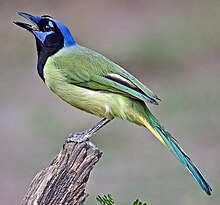Green jay
| Green jay | |
|---|---|
 |
|
| A green jay in Texas | |
| Scientific classification | |
| Kingdom: | Animalia |
| Phylum: | Chordata |
| Class: | Aves |
| Order: | Passeriformes |
| Family: | Corvidae |
| Genus: | Cyanocorax |
| Species: | C. yncas |
| Binomial name | |
|
Cyanocorax yncas (Boddaert, 1783) |
|
| Synonyms | |
|
Xanthoura luxuosa |
|
Xanthoura luxuosa
The green jay (Cyanocorax yncas) is a bird species of the New World jays, and is found in both North and South America. Adults are about 27 cm (11 in) long and variable in colour across their range; they usually have blue and black heads, green wings and mantle, bluish-green tails, black bills, yellow or brown eye rings, and dark legs. The basic diet consists of arthropods, vertebrates, seeds, and fruit. The nest is usually built in a thorny bush; the female incubates the clutch of three to five eggs. This is a common species of jay with a wide range and the International Union for Conservation of Nature has rated its conservation status as being of "least concern".
Green jays are 25–29 cm (9.8–11.4 in) in length. Weight ranges from 66 to 110 grams (2.3 to 3.9 oz). They have feathers of yellowish-white with blue tips on the top of the head, cheeks and nape, though some taxa have more blue than others. The breast and underparts range from bright yellow in the south to pale green in the north (e.g., Texas). The upper parts are rich green. It has large nasal bristles that form a distinct tuft in some subspecies, but are less developed in others. The color of the iris ranges from dark brownish to bright yellow depending on the subspecies.
Usually lumped with Inca jay (C. yncas yncas) of South America. Somewhat confusing in classification, the green jay is then used as the species name, even though the inca jay is the nominate subspecies. Some authorities split the two species with the Inca jay retaining the binomial C. yncas and the green jay adopting C. luxuosus.
Green jays feed on a wide range of insects and other invertebrates and various cereal grains. They take ebony (Ebenopsis spp.) seeds where these occur, and also any oak species' acorns, which they will cache. Meat and human scraps add to the diet when opportunity arises. Green jays have been observed using sticks as tools to extract insects from tree bark.
...
Wikipedia

